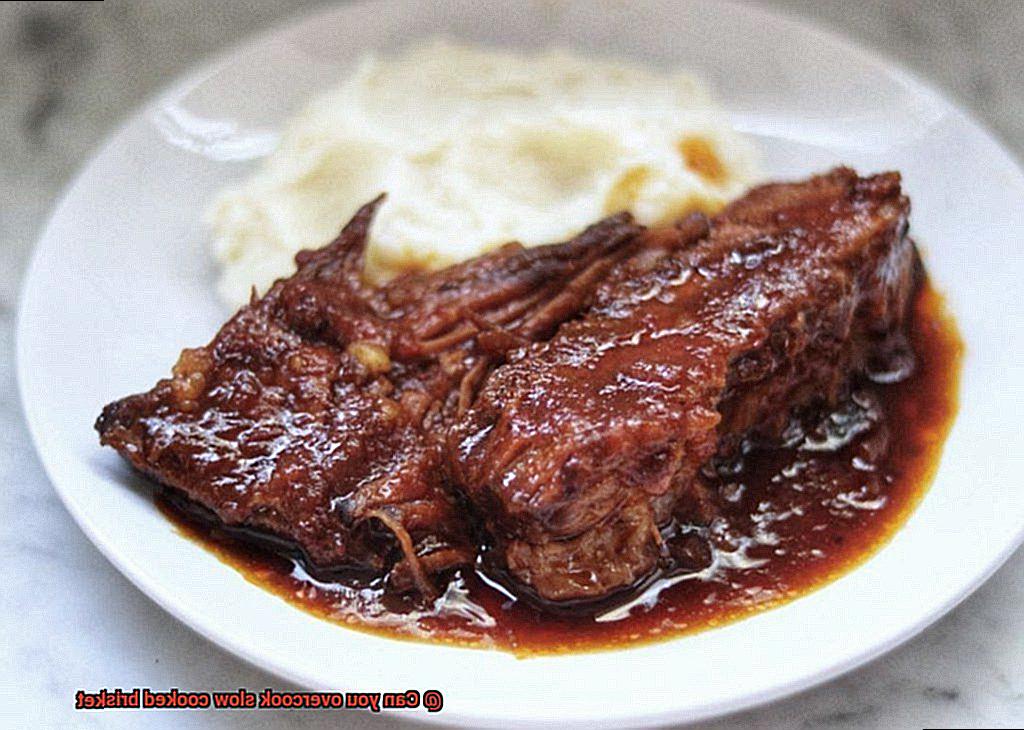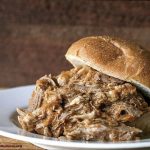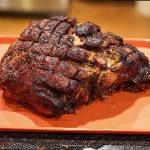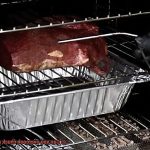Slow cooking, a timeless culinary technique, captivates food lovers with its promise of rich, melt-in-your-mouth flavors. And when it comes to slow-cooked brisket, few dishes can match its tender succulence. But let’s face it – there’s a thin line between perfection and disappointment in the kitchen.
In this tantalizing adventure through the realm of slow-cooked brisket, we’re diving headfirst into a question that has left many home chefs scratching their heads: Can you overcook this mouthwatering masterpiece? Join us on a quest to uncover the secrets behind achieving barbecue bliss with every bite.
Get ready to debunk myths, unravel the science, and sharpen your culinary skills. We’ll explore the crucial factors that determine whether your brisket will be a triumph or an overcooked letdown. So grab your aprons and let’s dive into the world of slow-cooked brisket – where deliciousness awaits at every turn.
Contents
Tough Nature of Brisket and the Need for Slow Cooking
Brisket, that tough and sinewy cut of meat, requires the art of slow cooking to transform it into a succulent masterpiece. At its core, the tough nature of brisket can be attributed to the abundance of connective tissue it possesses. Collagen, a type of connective tissue that envelops the muscle fibers, gives brisket its structure. However, if left unattended, this collagen can be as stubborn as a mule, resulting in a chewy and unpalatable eating experience.
Enter slow cooking—the magical technique that turns this tough beast into a tender delight. Slow cooking is the gentle whisper that persuades the collagen to break down and metamorphose into gelatin. This protein infusion adds moisture and tenderness to the meat, resulting in a final product so juicy and flavorful that it will dance across your taste buds with grace.
This low and slow approach not only disassembles the collagen but also allows for the gradual rendering of fat. Brisket boasts a generous layer of fat on top, which melts like liquid gold during the cooking process. As it seeps into the meat’s every crevice, it imbues it with an irresistible flavor and ensures that each bite is moist and divine.
Yet slow cooking offers more than just tenderness and flavor; it allows for a tantalizing infusion of spices, rubs, marinades, or smoke. With each passing hour, as the brisket leisurely cooks away, it soaks up these flavors like a sponge in water. The result? A final product that is rich in depth and complexity.
Nonetheless, caution must be exercised. Overcooking this delicate cut can spell disaster—rendering it dry and stringy. To ensure perfection, monitor the brisket’s internal temperature with diligence. A range of 195 to 205 degrees Fahrenheit is the sweet spot where collagen has fully surrendered, granting you a texture so tender that it effortlessly yields to the gentlest of forks.
Ideal Internal Temperature for Tender Brisket
The ideal internal temperature for tender brisket is a crucial factor in achieving a perfectly cooked piece of meat. Brisket, known for its toughness, requires low and slow cooking methods to break down the collagen and connective tissues, resulting in a tender and flavorful end product.
To accurately determine the internal temperature of the brisket, it is essential to use a reliable meat thermometer. Insert it into the thickest part of the meat, avoiding bones or fat, and take multiple readings from different parts to ensure accuracy.
As the brisket cooks, it goes through several stages. Initially, the internal temperature steadily rises until it reaches around 160°F (71°C). At this point, the collagen begins to break down slowly, leading to what pitmasters call the “stall” or “plateau.” During this stage, the temperature seems to plateau for several hours.
To overcome the stall, many pitmasters employ techniques such as wrapping the brisket in foil or butcher paper. This method, also known as the Texas crutch, accelerates the cooking process and shortens overall cooking time.
Once the brisket surpasses the stall, it continues cooking until it reaches the ideal internal temperature for tenderness. Experts agree that this range is between 195°F to 205°F (90°C to 96°C). Within this range, the connective tissues fully break down, resulting in a buttery and succulent texture.
However, it’s important to avoid overcooking beyond this range as it can lead to dry and tough meat. The collagen will have fully melted by then, and any additional cooking time can make the meat stringy and less enjoyable.
To ensure a perfectly cooked brisket, start checking for tenderness when the internal temperature reaches around 195°F (90°C). Use a toothpick or skewer to probe the meat. If it goes through with little resistance, the brisket is ready to be removed from the heat.
Overcooking Can Result in Dry and Stringy Meat
Overcooking can result in dry and stringy meat, especially when slow cooking brisket. Brisket, a tough cut of meat, requires cooking for an extended period to break down the connective tissues and make it tender. However, if the brisket is cooked for too long, it can become dry and stringy.
One of the main indicators that the brisket has been overcooked is its dryness. When a brisket is cooked for too long, it can lose its natural juices, leading to a dry and tough texture. The meat may become difficult to chew and lack the desired tenderness.
In addition to dryness, overcooking can also result in stringy meat. As the connective tissues continue to break down excessively, they can turn into strands that give the meat a fibrous and unpleasant texture. Instead of falling apart easily, the meat becomes difficult to pull apart, making it less enjoyable to eat.
To avoid overcooking brisket, there are several key steps you can take:
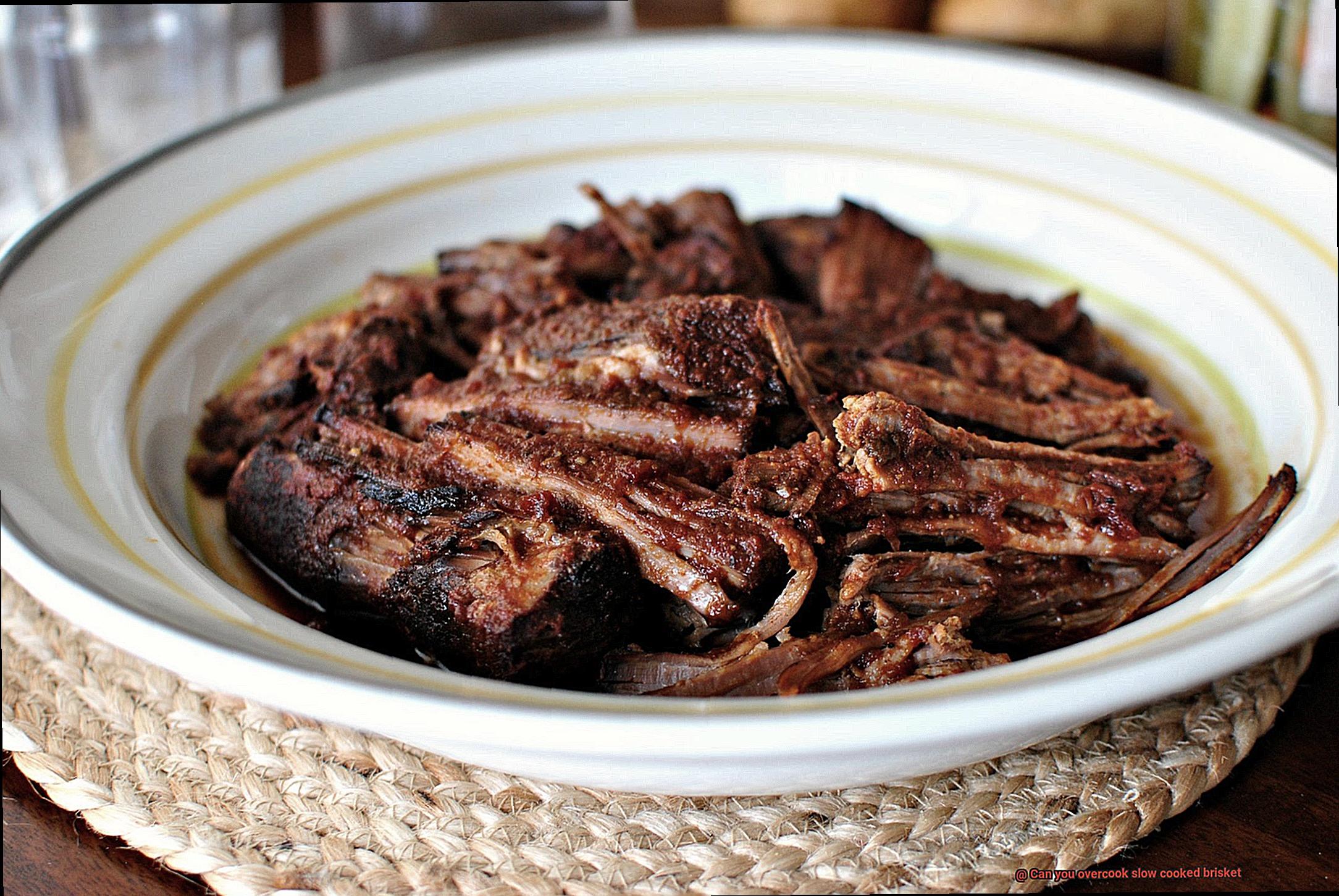
- Use a meat thermometer: To ensure that the brisket reaches the desired internal temperature without going beyond, use a meat thermometer. Generally, a brisket should be cooked until it reaches an internal temperature of around 195°F to 205°F. This range ensures that the meat is tender and juicy without becoming dry and stringy.
- Monitor cooking time: Adjust the cooking time based on the size and thickness of the brisket. A larger or thicker brisket will require more time to cook thoroughly. Keeping a close eye on the cooking time prevents overcooking.
If you find that your brisket has been overcooked and turned out dry and stringy, there are some ways to salvage it:
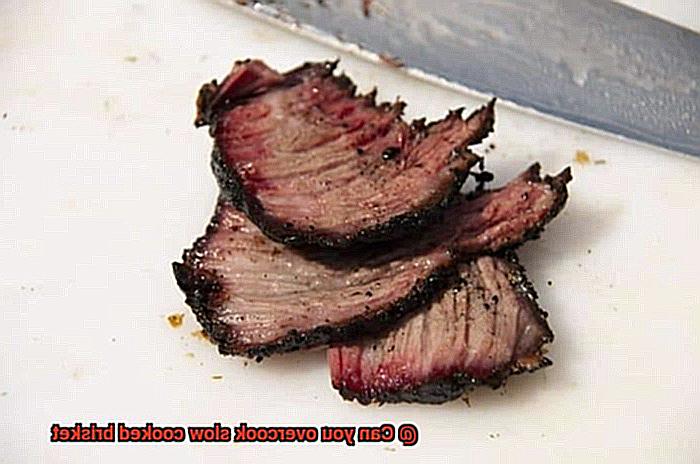
- Thinly slice against the grain: Slicing the meat thinly against the grain can help break up the stringiness. Cutting against the grain shortens the muscle fibers, making the meat easier to chew and improving its texture.
- Serve with flavorful sauce or gravy: Adding a flavorful sauce or gravy to the brisket can add moisture and enhance the overall taste. The sauce or gravy helps compensate for the dryness and adds a delicious element to the dish.
Monitoring the Cooking Process Closely to Avoid Overcooking
Monitoring the cooking process closely is of utmost importance when it comes to slow-cooking brisket in order to avoid the dreaded overcooking that can result in a dry and tough piece of meat. To ensure your brisket turns out tender and delicious, there are several key tips to keep in mind.
First and foremost, it is crucial to follow the recommended cooking times and temperatures. Different recipes may have variations, so referring to a trusted source or recipe will provide a guideline for how long your brisket should cook. This step sets the foundation for a successful cooking process.
In addition, using a meat thermometer is a cook’s best friend when monitoring the internal temperature of the brisket. The ideal temperature for a perfectly cooked brisket is around 195°F to 205°F. Inserting the thermometer into the thickest part of the meat, avoiding any bone or fat, allows for accurate temperature readings and prevents overcooking.
Setting a timer or alarm is another effective strategy. It is easy to get caught up in other tasks while slow-cooking, so setting a reminder ensures periodic checks on the brisket. This prevents forgetting about it and leaving it in the slow cooker for too long.
To further prevent dryness, basting or brushing the brisket with flavorful liquids every hour or so is highly recommended. This keeps the meat moist and infuses it with additional taste.
Lastly, allowing the brisket to rest for a few minutes before slicing and serving is crucial. This resting period allows the juices to redistribute throughout the meat, resulting in a more tender and flavorful final product.
Factors that Can Contribute to Overcooked Brisket
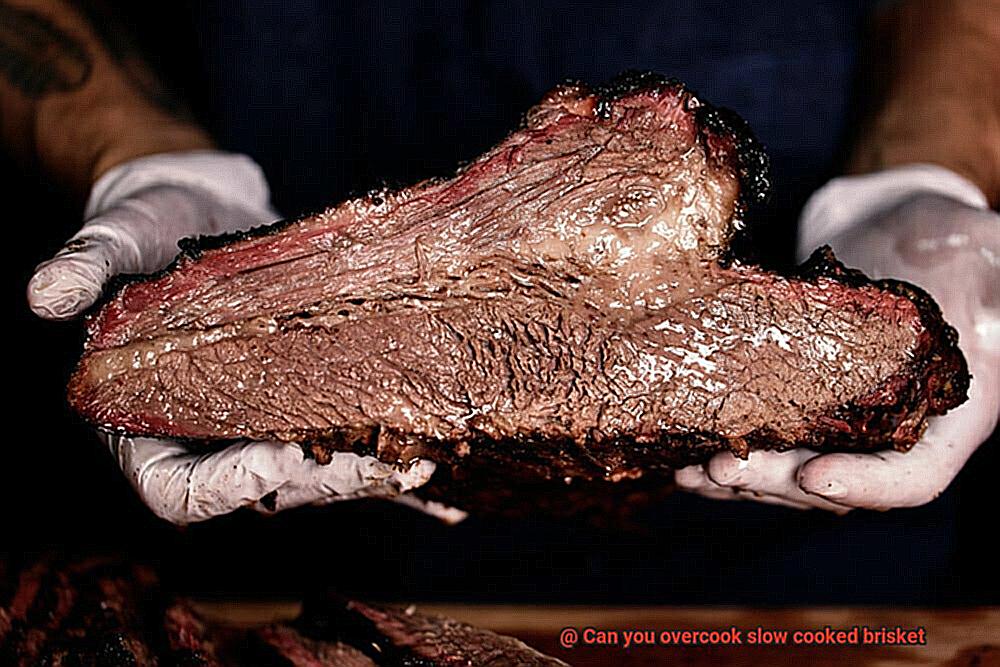
Factors that Can Contribute to Overcooked Brisket:
- Cooking Time: One of the primary factors that can contribute to overcooked brisket is the cooking time. Brisket is a tough cut of meat that requires low and slow cooking to break down the collagen and tenderize the meat. However, if it is cooked for too long, the meat can become dry and stringy, resulting in overcooked brisket. It is essential to follow the recommended cooking time for your specific recipe or adjust it based on the size and thickness of the brisket.
- Temperature Control: Another crucial factor in preventing overcooked brisket is maintaining proper temperature control throughout the cooking process. Slow cooking brisket requires a consistent low temperature, usually between 225-250°F (107-121°C). If the temperature is too high, the brisket can cook too quickly, leading to overcooking. Conversely, if the temperature is too low, the meat may take longer to cook, resulting in a dry and tough texture. Using a reliable meat thermometer to monitor the internal temperature of the brisket is highly recommended.
- Moisture Levels: Brisket contains a significant amount of fat and connective tissue, which helps keep the meat moist during cooking. However, if the moisture levels are not adequately maintained, the brisket can easily dry out and become overcooked. Basting or mopping the brisket with a flavorful liquid like a marinade or barbecue sauce can help retain moisture and prevent drying out during the cooking process. Additionally, wrapping the brisket in foil or butcher paper during a part of the cooking time, commonly known as the Texas crutch method, can also help retain moisture and prevent overcooking.
- Meat Quality: The quality of the brisket itself plays a significant role in determining whether it will end up overcooked or perfectly cooked. Choosing a high-quality brisket with proper marbling and thickness can make a difference in the final result. A well-marbled brisket has more fat distributed throughout the meat, which helps keep it moist and tender during cooking. Additionally, selecting the right size of brisket is important as larger briskets may take longer to cook and have a higher risk of becoming overcooked.
- Resting Period: Allowing the cooked brisket to rest before slicing is a crucial step that is often overlooked. Resting allows the juices to redistribute throughout the meat, resulting in a more tender and flavorful brisket. Skipping this step and slicing the brisket immediately after cooking can cause the meat to lose moisture rapidly, making it prone to drying out and becoming overcooked. It is recommended to let the brisket rest for at least 15-30 minutes before slicing and serving.
Recommended Cooking Time for Different Cuts of Brisket
Grilling a brisket can be intimidating, but fear not. With the right knowledge and techniques, you can achieve tender and flavorful results every time. In this guide, we will explore the recommended cooking times for different cuts of brisket, ensuring your next grilling adventure is a mouthwatering success.
The Two Main Cuts of Brisket:
- Point Cut: This cut boasts rich flavor and marbling, making it a favorite among barbecue enthusiasts. To unlock its full potential, it requires a longer cooking time of 8 to 12 hours, depending on the size and thickness. Patience is key when it comes to this decadent cut.
- Flat Cut: If you prefer a leaner option, the flat cut is perfect for you. With its uniform shape and less fat content, it cooks faster than the point cut. Typically, it takes around 6 to 8 hours to reach tender perfection.
Low and Slow Cooking:
To transform the tough collagen in brisket into succulent tenderness, low and slow cooking is essential. Maintaining a consistent temperature of around 225°F throughout the cooking process allows the flavors to develop and infuse into every fiber of the meat.
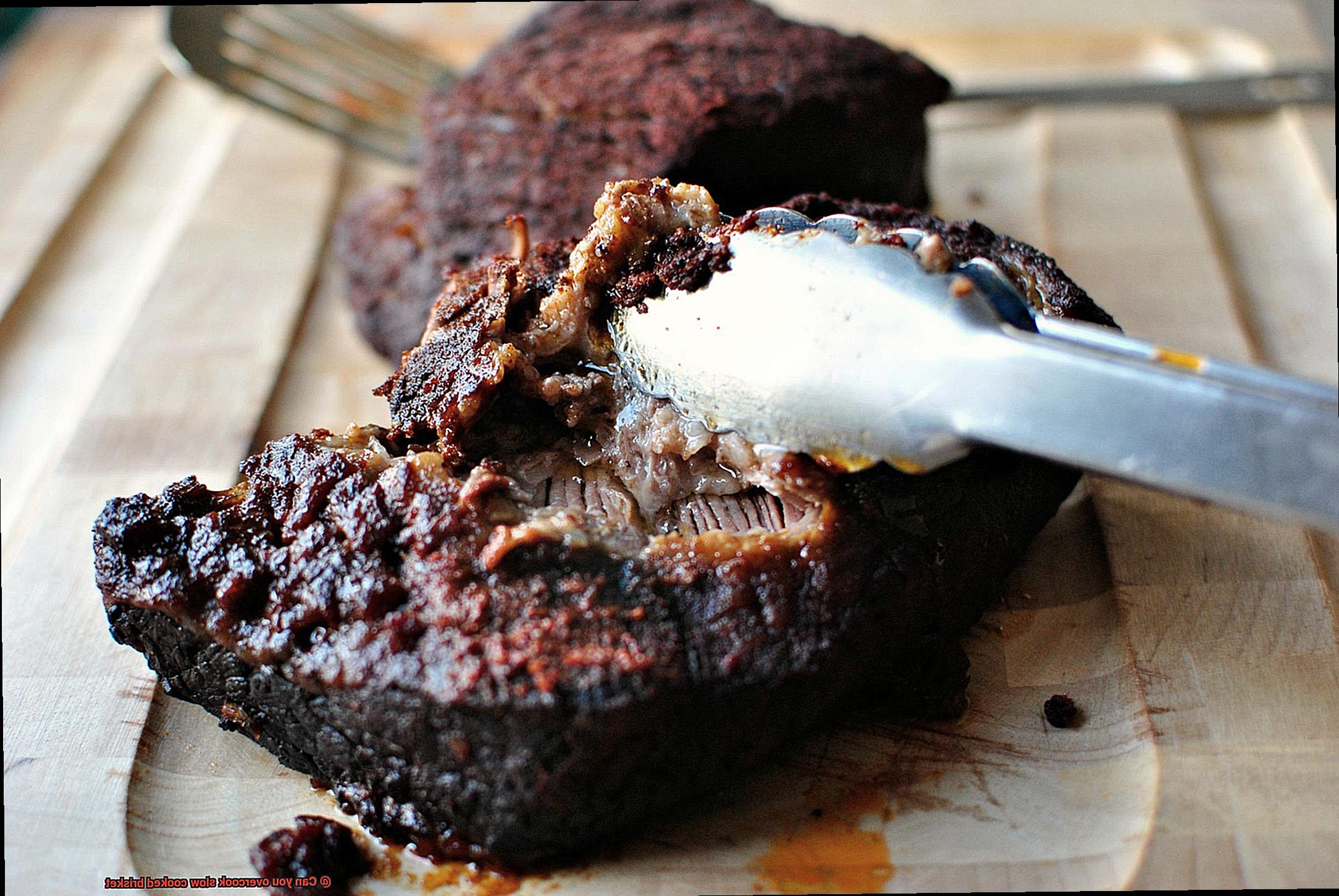
Internal Temperature:
Achieving the ideal internal temperature is crucial for perfectly cooked brisket. Using a reliable meat thermometer, monitor the progress until it reaches the range of 195°F to 205°F. Keep in mind that each piece may vary slightly, so be vigilant in your measurements.
Resting Period:
Once your brisket reaches the desired temperature, remove it from the grill and let it rest for at least 30 minutes before slicing. This important step allows the juices to redistribute throughout the meat, resulting in enhanced tenderness and juiciness.
Undercooking vs. Overcooking:
Brisket is forgiving when slightly undercooked rather than overcooked. If in doubt, it’s better to err on the side of caution and remove the brisket from the grill a little early. The resting period will finish the cooking process, ensuring a moist and tender outcome.
How to Salvage an Overcooked Brisket
Brisket is a tough cut of meat that, when cooked properly, becomes tender and flavorful. However, if you accidentally overcook your brisket, don’t worry. There are ways to salvage it and still enjoy a delicious meal. Here are some tips and techniques to help you salvage an overcooked brisket:
Assess the Damage
First, determine the extent of overcooking. If it’s only slightly overcooked, you have a better chance of salvaging it. If it’s severely overcooked, it may be more challenging to restore its tenderness.
Braise it Back to Life
Wrap the overcooked brisket tightly in foil or butcher paper and place it in a preheated oven at a low temperature, around 225°F to 250°F. This method, known as braising, allows the meat to slowly cook in its own juices, rehydrating it and breaking down the tough fibers.
Slow Cook for Moisture
Place the overcooked brisket in a slow cooker or large pot with a flavorful liquid like beef broth or barbecue sauce. Cook it on low heat for several hours, allowing the meat to absorb the moisture and become tender again.
Sous Vide Resurrection
If time permits, try using a sous vide cooker. Vacuum-seal the overcooked brisket and cook it at a precise lower temperature in a water bath. This slow cooking method will gradually bring the brisket back to its desired level of doneness.
Reheat with Care
When reheating the salvaged brisket, do so slowly and gently. Avoid high heat methods like grilling or broiling, as they can further dry out the meat. Instead, use methods that allow for gentle reheating, such as a slow cooker or a low oven.
Enhance the Flavor
Brush the salvaged brisket with a homemade barbecue sauce or marinade to add moisture and infuse delicious flavors. Consider slicing it against the grain when serving to further tenderize the meat.
Tips for Perfectly Cooked Slow Cooked Brisket
Choosing the right size brisket is crucial for achieving perfectly cooked slow cooked brisket. A large brisket may take longer to cook and could result in overcooking, while a small brisket may not have enough time to become tender. It’s best to choose a brisket that fits comfortably in your slow cooker or smoker and allows for even cooking.
Seasoning Generously:
Seasoning the brisket generously is essential for enhancing its flavor. Brisket can handle bold flavors, so don’t be shy when it comes to seasoning. Use a combination of salt, pepper, garlic powder, onion powder, and any other desired spices to create a flavorful rub. Massage the rub onto all sides of the brisket, ensuring an even coating.
Slicing Against the Grain:
When it comes time to slice the brisket, be sure to cut against the grain. This means cutting across the fibers of the meat rather than parallel to them. Slicing against the grain helps to ensure that each bite is tender and easy to chew. It also helps to break down the tough tissues and make the meat more tender.
Monitoring Internal Temperature:
Using a meat thermometer is essential for ensuring that your brisket is cooked to perfection. The ideal temperature for brisket is around 195°F to 205°F. Insert the thermometer into the thickest part of the meat, avoiding any bones or fat. This will help you determine when the brisket is done and prevent overcooking.
Allowing Resting Time:
Once the brisket reaches the desired internal temperature, remove it from the heat and let it rest for at least 30 minutes before slicing. This allows the juices to redistribute throughout the meat, resulting in a more flavorful and tender final product.
8Er9Hdnd50Q” >
Conclusion
Yes, you can absolutely overcook slow-cooked brisket.
It’s like turning a tender piece of meat into a dry, chewy disappointment. Picture this: your mouth watering as you take that first bite, only to be met with tough fibers and a lackluster flavor.
It’s a culinary tragedy that can easily be avoided with proper attention and care. So, keep an eye on that brisket while it simmers away in its savory juices.
Don’t let it go beyond the point of no return.

